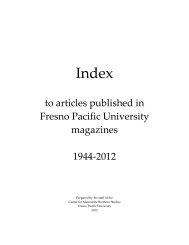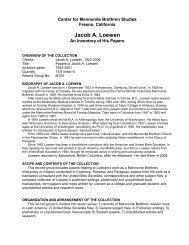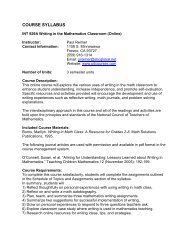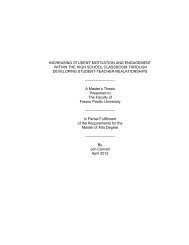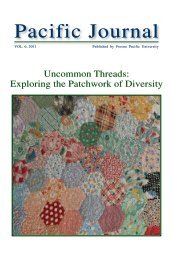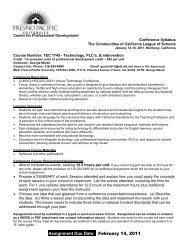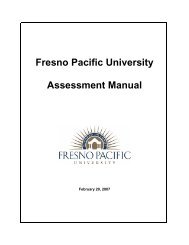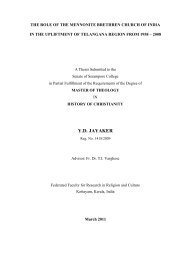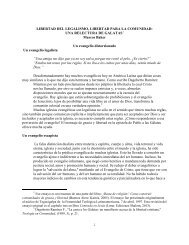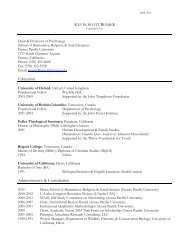Course Name and Number: LIB 79 â Library Management and ...
Course Name and Number: LIB 79 â Library Management and ...
Course Name and Number: LIB 79 â Library Management and ...
- No tags were found...
Create successful ePaper yourself
Turn your PDF publications into a flip-book with our unique Google optimized e-Paper software.
<strong>Course</strong> <strong>Name</strong> <strong>and</strong> <strong>Number</strong>: <strong>LIB</strong> <strong>79</strong> – <strong>Library</strong> <strong>Management</strong> <strong>and</strong> SupervisionInstructor’s <strong>Name</strong>: Karen Bosch CobbContact Information: Karen.BoschCobb@gmail.comHours: M-F 8:00 am to 5:00 pm559-217-1896 (cell preferred)559-822-2390 (home)<strong>Number</strong> of Units: 3Target Audience: <strong>Library</strong> Support Staff<strong>Course</strong> DescriptionThis online, asynchronous, independent study course will address library supervision <strong>and</strong>management including:Basic employment regulations <strong>and</strong> laws<strong>Library</strong> policies <strong>and</strong> procedures: evaluation of new <strong>and</strong> existing <strong>and</strong> the ability to upholdor make exceptions to policyPrinciples of staff selection, development, training, establishment of performanceexpectations, evaluation, promotion, discipline, <strong>and</strong> delivering difficult or sensitiveinformation.Leadership, management, supervision <strong>and</strong> teamwork; efficient <strong>and</strong> effective meetingsBudgeting, grant writing, <strong>and</strong> fund-raising <strong>and</strong> appropriateness of each; preparation <strong>and</strong>presentation, relationship to long range plan, outcomes, planning for new services<strong>and</strong> reductionsStrategic <strong>and</strong> long range planning of library services based on analysis of community<strong>and</strong> user needs, data <strong>and</strong> demographics; needs, <strong>and</strong> evaluation of existing <strong>and</strong> newservices; goals, objectives, measurementCooperation, collaboration, partnershipMarketing: planning <strong>and</strong> evaluationCustomer service <strong>and</strong> development of respect between staff <strong>and</strong> users.This course will prepare support staff to meet the library competencies as listed below. Students willprepare documents, complete online journals, prepare audio or visual reports, <strong>and</strong> respond to questionsfrom instructor. Students can register at any time for the course <strong>and</strong> they have one year to complete thecourse. Students will need to purchase the textbook separately from registering for the course.
UPON COMPLETION OF THIS COURSE THE STUDENT WILL BE ABLE TO DEMONSTRATETHE FOLLOWING COMPETENCIES AND WILL BE ABLE TO:Supervision Competencies<strong>Library</strong> Support Staff will know:1. Basic regulations <strong>and</strong> laws that govern employment; library policies, <strong>and</strong> procedures; <strong>and</strong> howpolicies are influenced by local, state, <strong>and</strong> federal laws <strong>and</strong> regulations.2. Principles of staff management, supervision, <strong>and</strong> discipline.<strong>Library</strong> Support Staff will be able to:3. Participate in recruiting, hiring, training, evaluating, <strong>and</strong> promoting library staff.4. Set clear performance expectations linked to the library’s strategies <strong>and</strong> priorities.5. Demonstrate leadership in a team environment.6. Plan, implement, <strong>and</strong> encourage participation in staff development activities.<strong>Management</strong> Competencies<strong>Library</strong> Support Staff will know:7. The value of written, approved policies <strong>and</strong> the difference between policies <strong>and</strong> procedures.8. The basic purposes <strong>and</strong> concepts of budgeting, grant writing, <strong>and</strong> fundraising.9. The value of planning library services based on community demographics <strong>and</strong> needs <strong>and</strong>evaluating these services.10. Principles <strong>and</strong> the value of cooperation <strong>and</strong> collaborating with other libraries, agencies, <strong>and</strong>organizations.11. Principles of marketing the library <strong>and</strong> its services.<strong>Library</strong> Support Staff will be able to:12. Develop realistic goals <strong>and</strong> measurable objectives after careful consideration of benefits, risks,<strong>and</strong> impact on library current <strong>and</strong> future needs.13. Develop, implement, <strong>and</strong> evaluate recommendations for new services <strong>and</strong> programs based onanalysis <strong>and</strong> interpretation of data about various aspects of library operations.14. Review existing <strong>and</strong> develop new policies <strong>and</strong> procedures.15. Develop <strong>and</strong> implement a marketing plan for the library <strong>and</strong> evaluate its effectiveness.16. Build positive relationships between staff <strong>and</strong> users, applying concepts of user-orientedcustomer service.17. Demonstrate the ability <strong>and</strong> willingness to uphold policies <strong>and</strong> decisions, <strong>and</strong> know whenexceptions are appropriate.18. Use appropriate strategies to deliver difficult or sensitive information.19. Identify community <strong>and</strong> user demographics, <strong>and</strong> assist in planning library services on thosedemographics <strong>and</strong> needs.20. Request, defend, <strong>and</strong> follow a budget for library activities.21. Conduct meetings effectively <strong>and</strong> efficiently.<strong>Course</strong> MaterialsPlease see Text Book <strong>and</strong> Online Resources. Text books are not included in course fees. In somecases you are asked to do your own research. You may do this in libraries of your choice or usingthe online library listed under Resources on the right h<strong>and</strong> side of the Moodle page.REQUIRED TEXT
Gieseck, Joan <strong>and</strong> McNeil, Beth. Fundamentals of <strong>Library</strong> Supervision, 2 nd The book can beordered at http://www.alastore.ala.org/detail.aspx?ID=2768 or http://www.amazon.com. Edition,ALA Editions, 2010, $55 ISBN 978-0-8389-1016-0.OPTIONAL TEXTWeing<strong>and</strong>, Darlene. Administration of the Small Public <strong>Library</strong>, 4 th Edition, ALA Editions, 2010, $48ISBN 978-0-8389-0<strong>79</strong>4-8. The book can be ordered athttp://www.alastore.ala.org/detail.aspx?ID=40 or http://www.amazon.com<strong>Course</strong> Requirements<strong>Course</strong> assignments are completed in Moodle asynchronously. If there are enough studentsenrolled at any one time the instructor will try to arrange for discussion forums or online chat.Students are required to1. Read all assigned texts <strong>and</strong> search for sources as assigned2. Complete all assignments listed <strong>and</strong> submit them in Moodle.Technology RequirementsBasic Technology: Students will need Internet access, underst<strong>and</strong> how to use send <strong>and</strong>receive email, know how to manage manage word processing files, be able to upload filesof completed assignments, <strong>and</strong> have a basic underst<strong>and</strong>ing of the Internet. The Instructordoes not provide assistance at this levelMoodle Site: This course will be delivered totally online. Moodle is a learning managementsystem that provides students access to online resources, documents, gradedassignments, quizzes, discussion forums, etc. with an instruction learning <strong>and</strong> useinterface. Click on Underst<strong>and</strong> Moodle – Student Tutorial in this section. To learn moreabout Moodle click here: http://docs.moodle.org/en/Student_tutorials.Getting Help: If you need help logging on to the Moodle site, contact The Help Desk atFresno Pacific University by telephone 1-559-453-3410 or email helpdesk@fresno.eduNational St<strong>and</strong>ardsALA-LSSC This course is designed <strong>and</strong> has been approved by ALA to teach the Competency Setfor ALA <strong>Library</strong> Support Staff Certification (LSSC) for Supervision <strong>and</strong> <strong>Management</strong>.http://alaapa.org/lssc/for-c<strong>and</strong>idates/competency-sets/Learning Objectives/OutcomesSee above under supervision competencies <strong>and</strong> management competencies.<strong>Course</strong> DatesThis is a self paced course; students may enroll at any time <strong>and</strong> have one year from the date ofregistration to complete the course. You cannot complete it in less than three weeks. Given thenature of the assignments, which require interviews with others, it is important to review the course<strong>and</strong> develop a plan for completing the course. Your plan should take into account your peak work<strong>and</strong> home obligations.
Schedule of Topics <strong>and</strong> Assignments# Module Assignments Objectives/Competencies1 Module 2 Reading Assignments: Fundamentals of <strong>Library</strong> Supervision: Chapter 7 <strong>and</strong>1http://www.dol.gov/compliance/guide/ <strong>and</strong> optional http://blog.librarylaw.com/librarylaw/employment/Basicemploymentregulations<strong>and</strong> laws· Online Journal: using two reading assignments above as foundation for U.S. laws <strong>and</strong> regulations,enumerate all Federal laws <strong>and</strong> regulations: In addition, list 2-3 State <strong>and</strong> Local (City, County, School,University, <strong>Library</strong> etc.) which govern the organization in which you work. Describe how new <strong>and</strong> existingemployees learn about regulations. Visit a library staff room to see which laws are posted <strong>and</strong> which arenot; list these.2 Module 3Principles ofstaff selection,development,training,establishmentofperformanceexpectations,evaluation,promotion,discipline,deliveringdifficult orsensitiveinformation.· Online Journal: Give two examples of legal employment issues you have encountered. Discuss action taken<strong>and</strong> whether it complied with laws at that time.Reading Assignment: Fundamentals of <strong>Library</strong> Supervision: Chapters 6, 7 (H<strong>and</strong>ling Complaints), 8, 9, 10,11, 14 (Skills for H<strong>and</strong>ling Problem Behaviors During Meetings), 15, 17, Optional Text Book Administrationof the Small Public <strong>Library</strong> Chapter 7· After reading the texts above write a paragraph each about procedures <strong>and</strong> policies for the following inyour library: employee job descriptions, job interviews, job interview teams, evaluating c<strong>and</strong>idates,making a job offer, setting performance expectations, training, career development, frequency ofevaluations, type of evaluations <strong>and</strong> how promotions are made. Consult with Human Resources staff ifyou are not familiar with policies <strong>and</strong> procedures <strong>and</strong> practices.· Next interview a manager in another type of library (i.e., if you are in a school library, visit a public orcollege or university library), <strong>and</strong> learn that library’s practice for the same items. Use a chart to compare<strong>and</strong> contrast the similarities <strong>and</strong> differences between the two libraries.· Using the job description for a classification you now or could supervise (in the next five years), write a listof interview questions, a list of acceptable <strong>and</strong> unacceptable answers, <strong>and</strong> explain the interview ratingscale you will use. List five questions which cannot or should not be asked <strong>and</strong> explain why not.· Next write out the training program for your new employee. Base your plan on information from Chapter 9of Fundamentals of <strong>Library</strong> Service. Explain why you chose the training methods you did. Be sure to2,3,4,6,18
inform the employee how his/her job is linked to the library’s strategic direction.· Plan a meeting with your new employee to discuss performance expectations <strong>and</strong> evaluation methods.Using audio or video relate what you will say. Use Chapter 10 <strong>and</strong> 11 <strong>and</strong> the evaluation methods ofyour current organization. Scan <strong>and</strong> send in a copy of the performance evaluation form used in yourorganization.· Pretend that your employee is not meeting attendance expectations, i.e., that he or she arrives at worklate about 6-8 times a month. His or her coworkers are very angry because they have to do the extrawork. Using audio or visual describe what you will say to the employee· Do One of the Following· Meet a Human Resources director in your library or organization’s Personnel Department <strong>and</strong>interview them about the discipline process in your organization. List the steps of discipline <strong>and</strong>get a written copy of the policies <strong>and</strong> procedures they use. Scan it <strong>and</strong> post in your onlinejournal.· OR· Your employee’s attendance has gotten even worse: Using the procedures in your organization,prepare a written warning <strong>and</strong> a written statement terminating your employee for unsatisfactoryattendance. These two documents should be directed to the employee. If possible, obtain <strong>and</strong>include your organization’s st<strong>and</strong>ard boilerplate language for such a document. However, themain focus should be on your findings <strong>and</strong> reasons for termination.· Do One of the Following· Respond to additional questions/comments made by the instructor about any of the assignments inthis module.· OR· Participate in an online discussion with students who are taking the course at the same time. Thediscussion will focus on students experience with disciplinary situations.
#3 Module 4Leadership,management,supervision<strong>and</strong> teamwork;efficient <strong>and</strong>effectivemeetings#4 Module 5<strong>Library</strong>policies <strong>and</strong>procedures:evaluation ofnew <strong>and</strong>existing <strong>and</strong>the ability touphold orReading Assignment: Fundamentals of <strong>Library</strong> Supervision: Chapters 2, 3, 4, 5, 14· Online Journal: Based on the readings explain in 150 words or less the differences between supervision,management <strong>and</strong> leadership.· Do one of the following· Participate in an online discussion with students who are taking the course at the same time. Thediscussion will focus on students experience with disciplinary situations.· OR· Answer questions posted by the instructor related to your comments.· Online Journal: There are many leadership theories. Read at least five articles on leadership; create <strong>and</strong>post a bibliography of the articles. Describe a leadership style your library director typically use <strong>and</strong> onenot used; compare <strong>and</strong> contrast these to your style penchants. Should you attempt to change your style?Answer questions posted by the instructor related to your comments.· Online Journal: submit an agenda for a meeting you regularly attend: either one that you lead or one thatsomeone else leads. Based on Chapter 14 describe what changes should be made to the meeting.Using ideas on teamwork, describe how you will go about introducing the suggested changes.· Online Journal or audio or video: describe the best team experience you have had in your work orpersonal life. Describe the worst. Using the Team Performance Characteristics outlined in Figure 5.1 inthe text book describe why your team succeeded or failed.Reading Assignments: Research <strong>and</strong> find five articles on identifying the need for new policies, developmentof policies <strong>and</strong> procedures, <strong>and</strong> documentation of a policies <strong>and</strong> procedure. Review existing policy <strong>and</strong>procedures (paper <strong>and</strong> electronic) in your organization. Optional Text Book Administration of the SmallPublic <strong>Library</strong> Chapter 5· Project: Using the information you learned, write a Guide to Writing Policies <strong>and</strong> Procedures Manual foryour library. Discuss pros <strong>and</strong> cons of publication methods such as paper, intranet, etc. Include abibliography <strong>and</strong> list of policy <strong>and</strong> procedures reviewed in your organization; the bibliography shouldinclude notations that are both descriptive <strong>and</strong> evaluative. (Descriptive means your notation briefly5, 211, 7, 14, 17
makeexceptions topolicydescribes what is relevant; evaluative means your opinion about what you read.)· Do one of the following5 Module 6Budgeting,grant writing,<strong>and</strong> fundraising<strong>and</strong>appropriateness of each;preparation<strong>and</strong>presentation,relationship tolong rangeplan,outcomes,planning forplanning <strong>and</strong>reductions· Online Journal: drawing from your experience write at least 250 words describing a time when youhad to uphold <strong>and</strong>/or enforce a library policy with which you did not agree.· OR· Online Journal or audio or video cast: drawing from your experience write, narrate or video (about150 words) describing a time when you made a decision to make an exception to a policy. Inretrospect would you make the same decision?Reading Assignment: Fundamentals of <strong>Library</strong> Supervision: Chapter 12, 16, Optional Text BookAdministration of the Small Public <strong>Library</strong> Chapter 2, 6,http://www.ala.org/ala/issuesadvocacy/advocacy/advocacyuniversity/budgetpresentation/index.cfm· Online Journal: Develop <strong>and</strong> post a bibliography on financial development strategies for a library. Interviewyour library director <strong>and</strong> an administrator in another library. Ask them to explain the different fundingpurposes of the library’s budget, grants, <strong>and</strong> fund-raising. Summarize the information in table format <strong>and</strong>post in your online journal.· Online Journal: Meet with your library’s business manager or accountant <strong>and</strong> ask them for an overview ofthe budget cycle <strong>and</strong> how the library prepares <strong>and</strong> monitors its budget. Ask your director how they preparetheir oral remarks to their governing board or council; in particular ask them to discuss whether the budgetis related to the library’s long range plan <strong>and</strong> outcomes. Summarize in written, audio or video format.· Online Journal: write about an experience you had preparing <strong>and</strong> presenting <strong>and</strong> monitoring a budget. Howdid your measure <strong>and</strong> evaluate the effectiveness of the funds spent? If you had to make reductions in thisprogram, what strategy would you use to plan <strong>and</strong> implement the reductions? Discuss your recommendedstrategies.· Obtain copies of three grants: one may be from your library. In 250-300 words compare <strong>and</strong> contrast the keyelements of the grants.8, 20
#6 Module 7Strategic <strong>and</strong>long rangeplanning oflibraryservices basedon analysis ofcommunity<strong>and</strong> userneeds, data<strong>and</strong>demographics;needs, <strong>and</strong>evaluation ofexisting <strong>and</strong>new services;goals,objectives,measurement#7 Module 8Cooperation,collaboration,partnershipSuggested Reading Assignments: Fundamentals of <strong>Library</strong> Supervision Chapter 16 <strong>and</strong>, Optional Text BookAdministration of the Small Public <strong>Library</strong> Chapter 3, or NEW Planning for Results: A Streamlined ApproachS<strong>and</strong>ra Nelson), or Free <strong>Management</strong> <strong>Library</strong>, Strategic Planning (in nonprofit or for-profit organizations)http://managementhelp.org/plan_dec/str_plan/str_plan.htm· Read the suggested texts above <strong>and</strong>/or find additional readings in order to complete the followingassignment. Write a paragraph each on how to identify a community, how to study the demographics of acommunity, mission, vision, goals, objectives. Explain input, output <strong>and</strong> outcome measurements. Write agoal, objective <strong>and</strong> measurement. Explain the cycle of planning. Post in Online Journal· Do one of the following:· Review demographics for the Queens <strong>Library</strong> <strong>and</strong> write, or use audio or video to describe how youcould use similar data to plan <strong>and</strong> evaluate library services for your library.http://www.queenslibrary.org/index.aspx?page_nm=Demographics· OR· Read The Engaged <strong>Library</strong>: Chicago Stories of Community Building.(http://urbanlibraries.org/associations/9851/files/ULC_PFSC_Engaged_0206.pdf): <strong>and</strong> explain whyor why not it is a sample of good planning <strong>and</strong> evaluation.· Obtain a copy of your library’s strategic plan <strong>and</strong> the copy of a plan for a library of the same size <strong>and</strong> type asyours. Compare <strong>and</strong> contrast the two; in particular comment on whether they are based on the needs ofthe community <strong>and</strong> how the planners will measure the success of the plan.Reading Assignment: Partnerships for Free Choice Learning:http://www.urban.org/UploadedPDF/410661_partnerships_for_free_choice_learning.pdf· Online Journal: In 150 words or less describe the difference between cooperation, collaboration <strong>and</strong>partnership.9,12,13,1910Online Journal: Many organizations <strong>and</strong> agencies like to cooperate, collaborate or partner with a library.Based on your reading <strong>and</strong> your experience, what guidelines would you use to determine which to pursue<strong>and</strong> which to decline? Describe in 250 words or less.#8 Module 9 Reading Assignments: Optional Text Book Administration of the Small Public <strong>Library</strong> Chapter 4, or a chapter 11,15
Marketingplanning <strong>and</strong>evaluation#9 Module 10Customerservice <strong>and</strong>developmentof respectbetween staff<strong>and</strong> usersor online document of your choice which explains the theory of marketing in a non-profit organization.· Interview the Public Information Officer of a <strong>Library</strong> in your area <strong>and</strong> ask them for their marketing plan fortraditional marketing. Discuss with them the role that social networking plays in their marketing plan.· Online Journal: Using the information you learned from the reading assignment <strong>and</strong> the interview, describe<strong>and</strong> discuss your library’s marketing plan <strong>and</strong> how it matches or does not match a theoretical plan forlibrary marketing. As a part of your review, scan in two samples of marketing pieces <strong>and</strong> discuss how theydo or do not fit the library’s marketing plan. If your library does not have a marketing plan, create a singlepage outline for a marketing plan.Reading Assignments: Optional Text Book Administration of the Small Public <strong>Library</strong> Chapter 4, or a chapteror online document of your choice which explains the theory of customer service in a library.· Review your library’s customer service policy, meet with a manager in your library to learn how it might beimproved, than design a training course which is suitable to the training needs of staff in your library:Search the web for ideas: Sample links: http://infopeople.org/training/contract/workshops/416· Visit three retails stores <strong>and</strong> two libraries in your area. At least one must be a bookstore; the libraries shouldbe different types of libraries, i.e., a public <strong>and</strong> a school, or a special library <strong>and</strong> a university library. Ifpossible, visit an Apple Store. Observe how staff provides service; write a paragraph about each.· Online Journal: Based on your observation use a single sentence or a word to describe what you believe isthe customer service model for the three stores <strong>and</strong> two libraries. Example: “People First!”· Next interview a manager at a store <strong>and</strong> a library <strong>and</strong> discuss their customer service philosophy. Did yoursingle sentence description capture the philosophy? If not, why not?16
Evidence of LearningThe instructor observed evidence of learning as demonstrated through successful completion ofall assignments explicitly described in the course material. Grading policies <strong>and</strong> Rubrics forevaluation are listed in section one. It is suggested that you print these <strong>and</strong> review while workingon <strong>and</strong> before submitting assignments.Instructor/Student ContactThe class provides many opportunities for contact <strong>and</strong> students are encouraged to email.ReferencesSee Text Books <strong>and</strong> Online Resources. It lists required readings <strong>and</strong> other resources.Policy on PlagiarismAll people participating in the educational process at Fresno Pacific University are expected topursue honesty <strong>and</strong> integrity in all aspects of their academic work. Academic dishonesty,including plagiarism, will be h<strong>and</strong>led according to the procedures set forth in the Fresno PacificUniversity Catalogue.University InformationFresno Pacific University is a Christian university located in the Central San Joaquin Valleyof California. It is fully accredited by the Western Association of Schools <strong>and</strong> Colleges(WASC). Graduate level course work reflects Fresno Pacific University’s Desired StudentLearning Outcomes as it applies to professional development to demonstrate the following:Oral <strong>and</strong> written communication in individual <strong>and</strong> group settingsContent knowledge, <strong>and</strong> application of such knowledge in the student’s area of interestto affect changeReflection for personal <strong>and</strong> professional growthCritical thinkingCultural <strong>and</strong> global perspectives to underst<strong>and</strong> complex systemsComputational/methodological skills to underst<strong>and</strong> <strong>and</strong> exp<strong>and</strong> disciplines, including anunderst<strong>and</strong>ing of technological systemsThe Fresno Pacific IdeaFresno Pacific University exists to prepare students for faithful <strong>and</strong> wise service throughexcellence in Christian higher education, <strong>and</strong> to strengthen the church <strong>and</strong> improve societythrough scholarship <strong>and</strong> service.Special NeedsIf you have a verified need for an academic accommodation or materials in alternate media (i.e.Braille, large print, electronic text, etc.) per the American with Disabilities Act or Section 504 ofthe Rehabilitation Act, please contact your instructor as soon as possible.
Grading Policies <strong>and</strong> RubricThe intent of this course is for you to achieve the competencies identified by ALA. These competenciesare listed in the Moodle Modules 2-23. Note that some competencies have been combined so thatevery module will not have an assignment or points. Your knowledge will be measured using agrading rubric.The Final grade will be based on the number of points earned. Pacific University does not grant creditfor coursework below a B.The point value for each assignment or type of assignment is listed below. Note that for assignmentsworth more than one point, the grade will be prorated. For example: if work merits 1 point, 1 will bemultiplied by 5 points for a value of 5 points. If work merits .8 points, .8 will be multiplied times 5points for a value of 4 points.You will only earn credit for the course if you achieve a grade of “A” or “B.” If the grade for anyassignment is below an A or B, you will be given one opportunity to improve upon the assignment. Ifyou do not do A or B quality work, that assignment will not accumulate points.Pass/fail is not offered for this course.The rubric below describes expectations on an assignment by assignment basis. Read this rubric asyou work on each assignment.You will submit a grade form when coursework has been completed.CompetenciesModuleMaximumPointsWelcome Quiz 1Basic employment regulations <strong>and</strong> laws 2 6Principles of staff selection, development, training, establishment ofperformance expectations, evaluation, promotion, discipline, deliveringdifficult or sensitive information. 3 30Leadership, management, supervision <strong>and</strong> teamwork; efficient <strong>and</strong>effective meetings 6 15<strong>Library</strong> policies <strong>and</strong> procedures: evaluation of new <strong>and</strong> existing <strong>and</strong> theability to uphold or make exceptions to policy 8 10Budgeting, grant writing, <strong>and</strong> fundraising <strong>and</strong> appropriateness of each;preparation <strong>and</strong> presentation, relationship to long range plan, outcomes,planning for planning <strong>and</strong> reductions 9 13Strategic <strong>and</strong> long range planning of library services based on analysis ofcommunity <strong>and</strong> user needs, data <strong>and</strong> demographics; needs, <strong>and</strong>evaluation of existing <strong>and</strong> new services; goals, objectives, measurement 10 9Cooperation, collaboration, partnership 11 3Marketing planning <strong>and</strong> evaluation 12 3Customer service <strong>and</strong> development of respect between staff <strong>and</strong> users 17 9Evaluation 1Maximum Total Points 100A = 90 to 100 points
B = 80 points to 90 pointsNo Credit = 0 points to <strong>79</strong> points. (One opportunity to do over.)Writing <strong>and</strong>ResearchPoint: .9-1 Point .8 -.9 Point 0 to .8 (No credit, oneopportunity to do over.)Quality ofInformationInformation clearly relatesto the main topic <strong>and</strong>provides all theinformation requested. Itincludes severalsupporting details <strong>and</strong>/orexamples if details <strong>and</strong>examples are relevant toassignment.Information clearlyrelates to the main topic<strong>and</strong> provides all theinformation requested. Itincludes 1-2 supportingdetails <strong>and</strong>/or examplesif details <strong>and</strong> examplesare relevant toassignment.Range of Information from has little ornothing to do with the main topic toinformation clearly relates to the maintopic but specifics are missing. Nodetails <strong>and</strong>/or examples are given ifdetails <strong>and</strong> examples are relevant tothe assignment.OrganizationInformation is veryorganized with wellconstructedparagraphs<strong>and</strong> subheadings.Information is organizedwith well-constructedparagraphsRange of Organization from appears tobe disorganized to information isorganized but paragraphs are not wellconstructedparagraphsMechanicsNo grammatical, spellingor punctuation errors.Almost no grammatical,spelling or punctuationerrorsRange of Mechanics from manygrammatical, spelling, or punctuationerrors to a few grammatical spelling orpunctuation errorsVideo orAudioPoint: .9-1 Point .8 -.9 Point 0 to .8 (No credit, oneopportunity to do over.)KnowledgeStudent showed excellentknowledge of content,needing no cues <strong>and</strong>showing no hesitation intalking or answeringquestions.Student showedexcellent knowledge ofcontent, but needednote cards to talk oranswering 1-2questions.Student showed excellent knowledge ofcontent, but often or always needednote cards to talk or answer questions.ClarityVideo did not rock/shake<strong>and</strong> the focus wasexcellent throughout.Video did notrock/shake <strong>and</strong> thefocus was excellent forthe majority of the video.Video had a little rocking/shaking, butthe focus was excellent throughout orProblems with rocking/shaking ANDfocus.Titles <strong>and</strong>CreditsAll titles <strong>and</strong> credits areaccurate, legible <strong>and</strong> drawthe viewer's attention.Most titles <strong>and</strong> creditsare accurate, legible<strong>and</strong> draw the viewer'sattention.Some titles <strong>and</strong> credits are accurate,legible <strong>and</strong> draw the viewer's attentionor fewer (less than 75%) titles <strong>and</strong>credits are accurate, legible <strong>and</strong> drawthe viewer's attention.
DiscussionForumsPoint: .9-1 Point .8 -.9 Point 0 to .8 (No credit, oneopportunity to do over.)Quality ofPostingThe student's post to theDiscussion Forum topicresponds to all criteriawithin the topic. Thecontent of the postdemonstrates a thoroughreflective process.The student's post to theDiscussion Forum topicresponds to most of thecriteria within the topic<strong>and</strong>/or the content of thepost demonstrates areflective process.The student's post to the DiscussionForum topic responds to a limitedamount of the criteria within the topic<strong>and</strong>/or the content of the postdemonstrates a limited reflectiveprocess or student did not post to thediscussion forum.MechanicsThe post contains nomajor grammatical,spelling, <strong>and</strong>/orpunctuation errors.The post contains somemajor grammatical,spelling, <strong>and</strong>/orpunctuation errorsThe post contains many majorgrammatical, spelling, <strong>and</strong>/orpunctuation errors.




